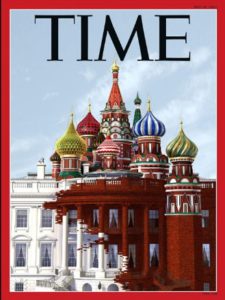 When Time magazine released their latest cover yesterday, which features the White House sprouting Russian-style onion domes, the first thing that popped into my mind was the Fireside Chat that FDR delivered on June 28, 1934.[1] The focus of the speech was a celebration of the legislative achievements of his first fifteen months in office and a promise of still more, vigorous legislative action to come. But the speech also responded to critics of the New Deal. And it is this passage of Roosevelt’s radio talk that the Time cover brought to mind:
When Time magazine released their latest cover yesterday, which features the White House sprouting Russian-style onion domes, the first thing that popped into my mind was the Fireside Chat that FDR delivered on June 28, 1934.[1] The focus of the speech was a celebration of the legislative achievements of his first fifteen months in office and a promise of still more, vigorous legislative action to come. But the speech also responded to critics of the New Deal. And it is this passage of Roosevelt’s radio talk that the Time cover brought to mind:
A few timid people, who fear progress, will try to give you new and strange names for what we are doing. Sometimes they will call it “Fascism,” sometimes “Communism,” sometimes “Regimentation,” sometimes “Socialism.” But, in so doing, they are trying to make very complex and theoretical something that is really very simple and very practical.
I believe in practical explanations and in practical policies. I believe that what we are doing today is a necessary fulfillment of what Americans have always been doing—a fulfillment of old and tested American ideals.
Let me give you a simple illustration:
While I am away from Washington this summer, a long-needed renovation of and addition to our White House office building is to be started. The architects have planned a few new rooms built into the present all too small one-story structure. We are going to include in this addition and in this renovation modern electric wiring and modern plumbing and modern means of keeping the offices cool in the hot Washington summers. But the structural lines of the old Executive office building will remain. The artistic lines of the White House buildings were the creation of master builders when our Republic was young. The simplicity and the strength of the structure remain in the face of every modern test. But within this magnificent pattern, the necessities of modern government business require constant reorganization and rebuilding.
If I were to listen to the arguments of some prophets of calamity who are talking these days, I should hesitate to make these alterations. I should fear that while I am away for a few weeks the architects might build some strange new Gothic tower or a factory building or perhaps a replica of the Kremlin or of the Potsdam Palace. But I have no such fears. The architects and builders are men of common sense and of artistic American tastes.
They know that the principles of harmony and of necessity itself require that the building of the new structure shall blend with the essential lines of the old. It is this combination of the old and the new that marks orderly peaceful progress, not only in building buildings but in building government itself.
Our new structure is a part of and a fulfillment of the old.
All that we do seeks to fulfill the historic traditions of the American people. Other Nations may sacrifice democracy for the transitory stimulation of old and discredited autocracies. We are restoring confidence and well-being under the rule of the people themselves. We remain, as John Marshall said a century ago, “emphatically and truly, a government of the people.” Our Government “in form and in substance . . . emanates from them. Its powers are granted by them, and are to be exercised directly on them, and for their benefits.”
The resonance of this passage with events today goes deeper than FDR’s (and Time‘s) image of White House architects building “a replica of the Kremlin.” FDR’s defense against accusations that the New Deal was undemocratic, that the US might, like other nations, “sacrifice democracy for the transitory stimulation of old and discredited autocracies,” was to emphasis – really to assert – the New Deal’s Americanness. Autocracy, fascism, communism, regimentation, even socialism, FDR suggested are essentially foreign. But his administration’s policies merely sought “to fulfill the historic traditions of the American people.” And there can be nothing to fear in that.
In fact, as Daniel Rodgers has told us in Atlantic Crossings, there was a vigorous, transatlantic exchange of social policy ideas from the late 19th century through the Second World War. The New Deal was not a purely American product and it was better for not being so.
 Nevertheless, FDR’s rhetorical move certainly made a lot of sense. Americans often like to think that our country is the font of all political good and that all political evil comes from abroad. A few short years after FDR gave this speech, the Communist Party of the United States would itself adopt the slogan “Communism is Twentieth-Century Americanism.” And this tendency to associate political good with America and political evil with other countries remains alive and well today.
Nevertheless, FDR’s rhetorical move certainly made a lot of sense. Americans often like to think that our country is the font of all political good and that all political evil comes from abroad. A few short years after FDR gave this speech, the Communist Party of the United States would itself adopt the slogan “Communism is Twentieth-Century Americanism.” And this tendency to associate political good with America and political evil with other countries remains alive and well today.
For good reason, people fear the authoritarianism of the Trump administration. And in the few short months since Trump was elected, among the chief interpreters of this danger has been the Yale historian Timothy Snyder, a specialist in the history of mid-twentieth century central and eastern Europe. On November 15, 2016, just a week after the election, Snyder wrote a Facebook post reflecting on what might be in store for the United States under a Donald Trump presidency. “Americans are no wiser than the Europeans who saw democracy yield to fascism, Nazism, or communism,” he began. “Our one advantage is that we might learn from their experience. Now is a good time to do so.” Snyder then presented 20 brief “lessons from the twentieth century” about the dangers posed by the rise of authoritarianism. Snyder’s post would eventually be shared nearly 18,000 times on Facebook. Within a few days, it was republished on the website of In These Times and in the pages of the Dallas Morning News. And within weeks, Snyder had expanded into a book, On Tyranny: Twenty Lessons from the Twentieth Century. Published by Penguin Random House in late February, On Tyranny quickly made it onto both the New York Times and Washington Post best-seller lists.
In fact, the chief sources of authoritarianism coming from this White House are deeply American. Many of them flow from Jeff Sessions’s Department of Justice, which, for example, is looking to expand voter disfranchisement and mass incarceration, two very traditional American modes of authoritarian governance.
Of course, the Trump Administration is also dealing with an ongoing scandal involving its secret and perhaps illegal ties with a foreign, authoritarian power. For a number of years, Russia has aggressively been promoting far-right nationalist parties in both Europe and North America as a way of furthering its own national interests. Though the effect will likely remain difficult to measure, in a very close election, the impact of Russian interference in our electoral process may not have been negligible. In that sense, Trumpian authoritarianism was partly empowered by a foreign, authoritarian system.
Clearly the image of the White House being transformed into the Kremlin[2] remains powerful enough that Time returned to it, probably without any thought to Roosevelt’s speech. But though I think Russian ties to the Trump campaign and the Trump administration are both disturbing and worth investigating, we should take little comfort from the fact that the White House will remain American in its look. There’s plenty of old and discredited authoritarianism in the American political tradition from which Trump and his administration can draw without any new ideas borrowed from Putin.
______________________________________
[1] Some of this post – though not the discussion of the Fireside chat – reworks material from a talk I gave on the Historians Respond to Trump panel at the recent OAH Meeting.
[2] Or, more precisely, Saint Basil’s Cathedral on Red Square.

2 Thoughts on this Post
S-USIH Comment Policy
We ask that those who participate in the discussions generated in the Comments section do so with the same decorum as they would in any other academic setting or context. Since the USIH bloggers write under our real names, we would prefer that our commenters also identify themselves by their real name. As our primary goal is to stimulate and engage in fruitful and productive discussion, ad hominem attacks (personal or professional), unnecessary insults, and/or mean-spiritedness have no place in the USIH Blog’s Comments section. Therefore, we reserve the right to remove any comments that contain any of the above and/or are not intended to further the discussion of the topic of the post. We welcome suggestions for corrections to any of our posts. As the official blog of the Society of US Intellectual History, we hope to foster a diverse community of scholars and readers who engage with one another in discussions of US intellectual history, broadly understood.
Thanks for this, Ben. I love the Fireside Chat excerpt, and the connection you made with it. It occurs to me that the battle you’re waging here is a kind of older one–i.e. against American exceptionalism. I thoroughly approve of that campaign, whether in relation to external forces or internal ones. – TL
Thanks for this Ben. This was really interesting. It has struck me as interesting that the Democratic Party, both elected and those in the media more sympathetic to their party over Trump, have seemed to make this a more Cold War rehash of possible US succumbing to the “evil empire,” when in fact there could be a much more populist, and arguably accurate, attack made that ties Trump to Russia for what he really is– a corrupt mega-capitalist with international connections for his own personal fortune.
Again, though, this was a good piece. Thanks for sharing.